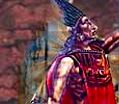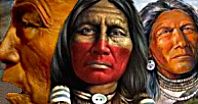|
|  |

ONEOTA and LATE WOODLAND INDIAN CULTURES
ANCIENT INDIAN CIVILIZATIONS

Oneota Discovery in Wisconsin stirs scientific debate: Did two different cultures meet?
AUTHOR: Susanne Quick, Milwaukee Journal Sentinel staff writer
Onalaska - Nestled in a beautiful, verdant valley along the Mississippi River, a great feast took place nearly 1,000 years ago.
In what appears to be something like an ancient Thanksgiving dinner - albeit with dog meat instead of turkey - people of two different cultures met, exchanged food, ideas and possibly gave birth to an entirely new cultural tradition.
In a pit of dirt, cleared by bulldozers for the building of a subdivision on the outskirts of Onalaska, Robert "Ernie" Boszhardt, a regional archaeologist from the University of Wisconsin-La Crosse's Mississippi Valley Archaeology Center, discovered evidence of a rare cultural exchange, one that he believes will have an impact on the way we interpret and understand Wisconsin archaeology.
"We never expected to find anything like this," Boszhardt said. "It took us completely by surprise."
What they found was evidence of the intermingling of Late Woodland and Middle Mississippian cultures,at about A.D. 1050, in the La Crosse region.
"This could be the staging ground for later Oneota culture," Boszhardt said.
The archaeological history of Wisconsin between A.D. 1000 and 1200 is messy. And the site at Onalaska - with evidence of two distinct cultural pottery types at the same hearth - may help to put that confusion to rest, Boszhardt said.
Before A.D. 1000, researchers are fairly confident about who lived in the state: It was the Late Woodland culture. These were the people who built effigy mounds, such as the ones on the UW-Madison campus.
The effigy-mound builders probably moved around a bit - never staying in one place too long. They fed themselves from the meat they hunted and the foods they gathered in the woods and grasslands around them.
After A.D. 1000, this culture vanished. In 1200, a new one, called Oneota, took its place. These later people were agricultural. They ate and grew corn, and were pretty sedentary, Boszhardt said.
Hotly debated subject
So what happened between the disappearance of the first group and the arrival of the second remains a sticky - and sometimes fiercely debated - subject.
Some believe the Late Woodlanders became Oneota, via cultural influence from an outside source.
But others, namely David Overstreet at Marquette University, think they were pushed out by marauding and expanding groups of Oneota from the East.
What is known about this period is that an impressively complex and thriving community was built in what is now Illinois, just across the river from St. Louis.
There, a city called Cahokia came to life.
A thriving metropolis, this city at its heyday was home to nearly 25,000 people, said Robert Birmingham, an archaeologist with the Wisconsin Historical Society in Madison.
"That's bigger than London was at that time," Birmingham said. "This was a city. I mean it rivals some of the Mayan stuff we see from Central America."
With temples, a plaza in the center of the city, and fortified walls surrounding the inner metropolitan area, Cahokia was a powerful and grand center.
And the people who lived there are known as the Middle Mississippians.
"I don't think these were a particularly happy or peaceful lot," said Birmingham, who referred to evidence of large, ritualistic human sacrifices at Cahokia, as well as indications of cannibalism.
Evidence of these people can be found throughout the Midwest and Southeast. It is suggested that modern Native American tribes, such as the Creek, Chickasaw and Natchez, are the historical remnants of this culture.
In Wisconsin, it was the Middle Mississippians who established the fortressed village at Aztalan, an archaeological site on the banks of the Crawfish River, near Lake Mills.
"There are signs of human butchering and cannibalism there, too," Birmingham said.
And there is evidence suggesting that Late Woodland people were living alongside.
Role of Middle Mississippians
The issue, according to James Stoltman, a retired professor of archaeology at UW-Madison, is what role the Middle Mississippians had on the transfer of Late Woodland to Oneota culture.
"I think this new evidence from Onalaska, as well as from other sites around the state, indicate that there was a marriage of culture between the Late Woodland and Middle Mississippian," which gave birth to the Oneota, Stoltman said.
He points to Boszhardt's discovery of both Late Woodland and Middle Mississippian pottery types at the same hearth; suggesting that a meal was shared between the two groups.
"We don't see Oneota anywhere before 1000 A.D.," he said. "So, arguments for Oneota coming into the state and pushing the Late Woodlanders out are baseless. They didn't exist, so they couldn't have done that."
Stoltman, Boszhardt and Birmingham also point to archaeological objects, such as pottery, to further their argument of a cultural blending between Late Woodland and Middle Mississippian traditions.
"Early Oneota looks like a mix of the two," Stoltman said.
Three separate cultures?
But Overstreet, who is also director of the Center for Archaeology Research in Milwaukee, disagrees.
He believes that these three cultures are separate; that there was no "marriage" or "birth" in any combination between any of the groups.
He points to radiocarbon dates that he collected from Oneota pottery in northeastern Wisconsin, which show this group's presence as early as A.D. 900.
"The Oneota came in and pushed the effigy-mound people out. They just kept moving west, sweeping Late Woodland across and out of Wisconsin," Overstreet said.
The Aztalan and Onalaska evidence - the latter which he has not seen - are indications of the fierce, powerful state of Cahokia; which probably, like Rome, sent troops out to put the neighboring tribes in order.
"Aztalan is a fort in Cahokia's frontier," Overstreet said. "It is surrounded by walls. And you don't see a scrap of any later Oneota culture from here. Nothing."
The new evidence at Onalaska, said Overstreet, is probably just a one-time event in which Cahokian troops or traders moved up the river checking in on their frontier folk.
"We really have never understood what role these people (Middle Mississippians) were playing at these sites," Overstreet said. "But, I think they were here to put people in line."
A difference of opinion
"That's bunk," Boszhardt said. "His radiocarbon dates are bad."
Stoltman agrees.
"When you look at dates, you have to pick the median. Where do most of the dates fall?" he said. "You can't pick those at the extremes."
Whatever the results from Onalaska eventually show, the site will be reburied under a new development of houses and condominiums.
"This way, in another 1,000 years, someone else can come along and look at this same stuff, and figure it out from there," Boszhardt said.
SOURCE:
Susanne Quick is a staff writer for the Milwaukee Journal Sentinel. She can be reached at squick@journalsentinel.com
RELATED ARTICLES:
Mississippi Mound Builders Overview
Cahokia moundbuilders
Cahokia Mounds art exhibit showcases moundbuilder artifacts: Hero, Hawk and Open Hand
Once the most numerous peoples in Florida, the Ais are now extinct
Cahokia Mounds State Historic Site
|
 |


|
|
| | | | | | | | |
 |
|
|

